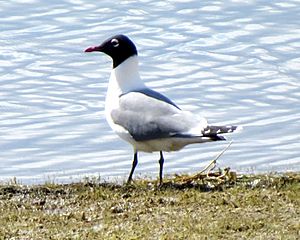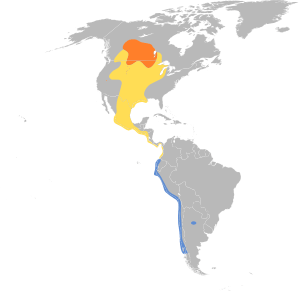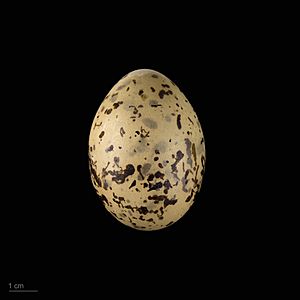Franklin's gull facts for kids
Quick facts for kids Franklin’s gull |
|
|---|---|
 |
|
| In Calgary, Alberta | |
| Conservation status | |
| Scientific classification | |
| Genus: |
Leucophaeus
|
| Species: |
pipixcan
|
 |
|
| Synonyms | |
|
Larus pipixcan |
|
The Franklin's gull (Leucophaeus pipixcan) is a small type of gull. It is about 32 to 36 centimeters (12.6 to 14.2 inches) long. Its scientific name, Leucophaeus pipixcan, comes from Ancient Greek words meaning "white" and "dusky," and a Nahuatl word for a type of gull.
Contents
What Does a Franklin's Gull Look Like?
These gulls have a white body. Their back and wings are a darker grey compared to other gulls of similar size. Their wings have black tips with a white band next to them. Both their beak and legs are red.
When they are breeding, adult gulls have a black head, like a hood. This black hood mostly disappears in winter. Young gulls look similar to adults but have less black on their heads and do not have the white band on their wings. It takes them three years to become fully grown.
Here are some typical measurements for a Franklin's gull:
- Length: 32 to 36 centimeters (12.6 to 14.2 inches)
- Weight: 230 to 300 grams (8.1 to 10.6 ounces)
- Wingspan: 85 to 95 centimeters (33.5 to 37.4 inches)
Where Do Franklin's Gulls Live and Travel?
Franklin's gulls breed in the central parts of Canada and nearby states in the northern United States. They are migratory birds, which means they travel long distances. For winter, they fly south to warmer places like Argentina, the Caribbean, Chile, and Peru.
While they are common in their breeding areas, it is rare to see them on the coasts of North America. Sometimes, they wander far from their usual paths. They have been seen in places like northwest Europe, southern and western Africa, Australia, and Japan. There was even one sighting in Eilat, Israel, in 2011, and another in Larnaca, Cyprus, in 2006. In early 2017, one was also seen in Southern Romania, in southeast Europe.
How Do Franklin's Gulls Behave?
Like most gulls, Franklin's gulls are omnivores. This means they eat both plants and animals. They will also scavenge for food, picking up whatever they can find, and hunt for small prey.
In the spring, you might see large groups of them floating on rivers, like the Bow River. They gently float along, sipping up insects that are hatching from the water. They often float through a certain part of the river and then fly back to do it again.
Reproduction and Life Cycle
These birds build their nests in colonies, which are large groups of birds living together. They usually nest near prairie lakes. Their nests are built on the ground, or sometimes they even float on the water. The female gull lays two or three eggs, and the parents take care of them for about three weeks until they hatch.
Why Are They Called Franklin's Gulls?
This bird was named after Sir John Franklin. He was an Arctic explorer who led an expedition in 1823. During this trip, the very first specimen of a Franklin's gull was collected, which is why the bird carries his name.
See also
 In Spanish: Gaviota de Franklin para niños
In Spanish: Gaviota de Franklin para niños



